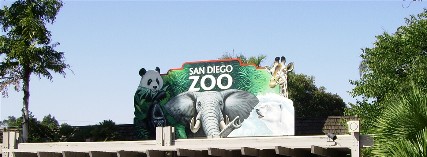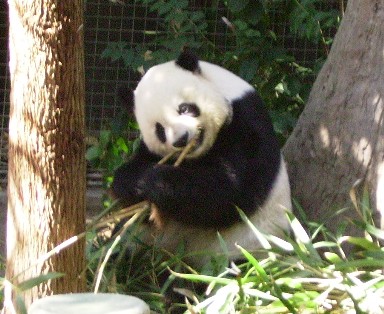|
San
Diego Zoo
The
San Diego Zoo is world renowned for being home to 4,000+
animal from over 800 species as well as a substantial
botanical gardens. The zoo is operated by the Zoological
Society of San Diego, which was founded in 1916 and
is the largest zoological society in the world. First
off, the zoo is a huge place and there is no clear sequence
of traffic flow, so you go to whatever you are interested
in first. The sequence below is the path we took, which
was somewhat dependent on what my daughter was interested
in at that instant versus some underlying plant. My
suggestion is that you first take the bus tour.to give
you some idea of what is around the zoo and then decide
where to go on foot.
|
Entrance
Just to the left of the entrance is the stroller
rental and information. Stroller rental is suggested
for small kids as they will likely be tired from
all the walking especially due to the steep grades
in places.
Children's
zoo
Just to the left of the entrance is the Children's
zoo. Over 30 animal exhibits for kids and adults.
You might see macaws, pygmy marmosets, wombats,
and spider monkeys. Also there is a petting zoo
area with goats, sheep, and other animals you
can touch and feed (be sure to wash hands afterward!).
Skyfari
The skyfari is an arial tram that runs from one
corner of the zoo to the other. Be advised that
it is a one way trip and if you want to come back
you will have to stand in line again or walk,
so don't leave your stroller with anything valuable
while you ride.
|

|
|

|
Reptile
House and Mesa
The Reptile House is home to snakes of all kinds,
tortoises, and gila monsters. Most kids won't
have any problems since they are safely behind
glass, but some look pretty intimidating. Reptile
Mesa is home to some rock iguanas from South America,
tortoises, and a different looking type of crocodile.
If you are not careful you might miss the small
exhibits inside on either side of the mesa which
contain frogs, toads, salamanders, and smaller
turtles.
Monkey
Trails
An elevated walkway from the entrance will give
you a unique view of the monkey habitats as if
you are up in the trees yourself.
Absolutely
Apes
Absolutely Apes contains the many orangutans and
siamangs of the San Diego Zoo. It is a pretty
large habitat with glass on one side that features
numerous trees, play structures, ropes, and sway
poles.
Gorilla
Tropics
Gorilla Tropics is simulation of an African
rain forest. The gorilla area has waterfalls,
and open grassy area, and climbing areas. It was
a little strange when near the glass fronted viewing
area when there was two gorillas sitting looking
at the people on the other side, and one obviously
showing off for the crowd...
|
|
Scripps
and Rain Forest Aviary
Walking through these enclosures makes you imagine
you were in Africa. Birds are flying free among
native flora. We were there on a cool day and
the birds seemed to be prety active and not that
shy of the people (probably since there were so
few).
Tiger
River
Tiger River is home to, yes you guessed it, tigers.
Also fishing cats, tapirs, crocodiles and a few
species of birds also call this area home.
Ituri
Forest
The Ituri Forest habitat is named for the real
Ituri Forest, which is an equatorial rain forest
in the Democratic Republic of Congo. At the San
Diego Zoo it is home to species such as hippos,
okapis, and Turacos (among others). This is one
of the few areas that has several species in one
enclosure. It was interesting for us to sit and
watch them as they played together. We used this
as an object lesson for our daughter.
Giant
Panda Research Station
The Giant Panda Research Station is obviously
one of the biggest draws of the San Diego zoo.
There are currently six giant pandas at the San
Diego zoo. As you enter the enclosure there is
a zoo employee there to talk about what the pandas
are doing and answer any questions.
|

|
|

|
Polar
Bear Plunge
There are four polar bears which call the San
Diego Zoo home. As you enter the area you can
see them close up underwater. If they happen to
be taking a swim, it is surprising how agile they
can be! The one I was watching, actually came
up to the window and was checking us out (but
my camera was out of batteries). At the picture
to the left I think one of the keepers had left
something in the enclosure as this bear was digging
at something which he eventually ended up eating...
The water in the plunge is cooled to about 55
degrees Fahrenheit (12 degrees Celsius) so it
will be comfortable.
Horn
and Hoof Mesa
Following the Polar Bear Plunge, the road winds
through Horn and Hoof Mesa, which is home to a
number of gazzeles, zebras, giraffes and other
animals of the plains of Africa. There was a baby
giraffee when we were there that was only six
weeks old. The driver on the bus tour told us
that baby giraffes give birth standing and the
baby comes out and hits the ground. Talk about
a rude awakening!
|
|
Cat
Canyon
Along Cat Canyon are goats, pigs, small meat eating
animals and cats. If you want to get a veiw of
these cats, especially the jauguars, you probably
need to make it a point to get there early. We
saw them out walking when we took the bus tour,
but by the time we got around to them of foot
it was early afternoon and they were all sleeping.
Bear
Canyon
Along Bear Canyon are lions, bears, and a few
species of monkeys. As with the cats above, you
need to get to them early in the day to see them
active.
Elephant
Mesa
Elephant Mesa is a interesting area with a number
of elephants. Some were obtained prior to culling
from two major game reserves in the Kingdom of
Swaziland. There are a number of items placed
in the habitat for them to play and interact with
as seen on the right. While many might think that
these animals should be returned to the wild,
these were rescued prior to being culled. I think
it is preferable for them to be here than not...
|

|
|

